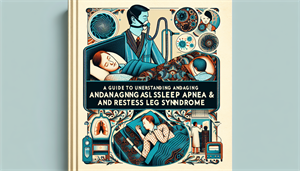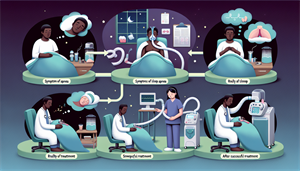
Welcome to an enlightening journey into the intricate world of sleep disorders
We invite you to explore the significant connection between sleep apnea and Restless Leg Syndrome (RLS), and the profound impact these conditions can have on your sleep quality and overall health, if left unchecked. Ready to embark on this enlightening voyage? Let’s dive in!
Key Takeaways
-
Sleep Apnea and Restless Leg Syndrome (RLS) are linked with a substantial increase in insomnia when comorbid, and treatments such as CPAP for Sleep Apnea can improve RLS symptoms.
-
Diagnosing Sleep Apnea typically involves a sleep study, while RLS diagnosis is based on medical history, symptom description, and sometimes blood tests, with treatment for each affecting the management of the other.
-
Lifestyle modifications such as improving sleep hygiene, exercising, maintaining a balanced diet, and joining support groups can be important in managing both Sleep Apnea and RLS effectively.
The Connection Between Sleep Apnea and Restless Leg Syndrome
Sleep apnea and Restless Leg Syndrome (RLS) are more than just bedfellows. Research indicates that approximately 24.4% of patients with Obstructive Sleep Apnea (OSA) also battle with RLS, making it a case of comorbid RLS. This comorbid occurrence can significantly disrupt sleep and increase instances of insomnia, compared to individuals with OSA alone.
The good news is that treating sleep-related breathing disorders like OSA has shown considerable improvement in RLS symptoms, especially with continuous positive airway pressure (CPAP) therapy. Managing RLS in OSA patients often involves assessing for iron deficiency and administering oral iron supplements if necessary.
For those without iron deficiency, treatment may include the use of medications such as dopamine agonists. Thus, the link between OSA and RLS underscores the importance of comprehensive treatment strategies to alleviate both conditions for improved sleep quality and overall health.
Symptoms of Sleep Apnea and RLS
Significant disruptions in sleep patterns and daily life are common symptoms shared by sleep apnea and unsuspected restless legs syndrome rls. Some common symptoms include: Difficulty initiating sleep, frequent awakenings during the night, excessive daytime sleepiness, uncontrollable urge to move the legs, often due to an uncomfortable sensation, urge to move the legs usually occurs during the evening or nighttime when in a seated or lying position, movement provides temporary relief from discomfort.
These symptoms can be a real sleep disruptor for individuals with sleep apnea or RLS. Decreased sleep efficiency coupled with these sleep disruptions can lead to substantial daytime sleepiness, potentially impairing daily functionalities. Imagine the frustration of seeking rest after a long day, only to be greeted by an incessant urge to move your legs or interrupted breathing patterns. Tackling these symptoms is a vital move towards restoring peaceful nights and rejuvenating days.
Risk Factors for Both Conditions
There are specific risk factors that raise the chances of developing sleep apnea and RLS. Shared risk factors for these conditions include: Obesity, family history, specific medical conditions such as type 2 diabetes, congestive heart failure, high blood pressure, Parkinson’s disease, and chronic obstructive pulmonary disease.
Obesity, for instance, is associated with a higher probability of developing both sleep apnea and RLS, primarily due to factors like heightened fat accumulation, which can impact breathing during sleep and overall body health. Family history also plays a crucial role, as there is often a genetic predisposition for these conditions, including sleep apnea syndrome and periodic limb movement disorder.


